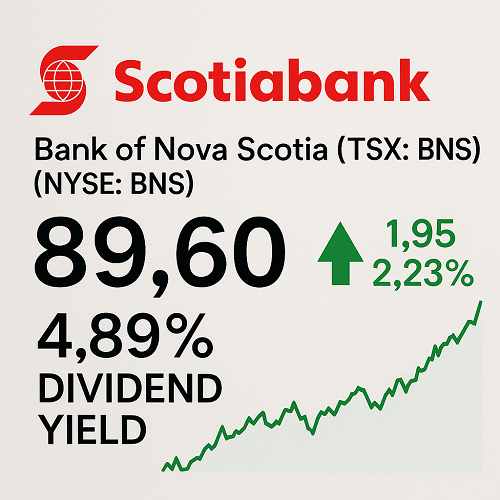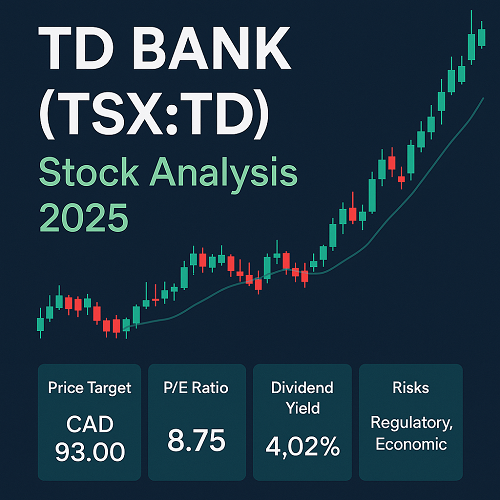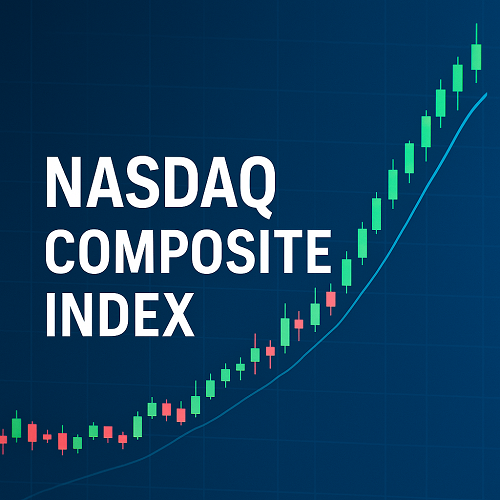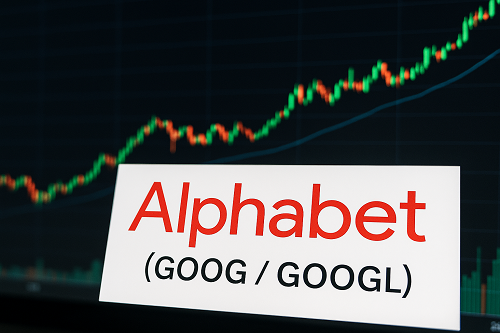The Bank of Nova Scotia (commonly “Scotiabank”; ticker: BNS on both TSX and NYSE) is one of Canada’s “Big Six” banks. For those interested in investing, keeping an eye on BNS stock on the TSX could be worthwhile. It operates across domestic Canadian banking, international banking (Latin America & Caribbean), wealth & capital markets, and global corporate banking. The bank has been repositioning its portfolio in recent years—shifting focus away from some underperforming international operations and increasing strength in core markets.
Recent Price & Key Metrics
| Metric | Value |
|---|---|
| Current TSX Share Price (approx) | C$89.60 |
| 52-Week Range | Low: C$62.57 – High: C$90.00 |
| Market Cap | ~ C$110–111 billion |
| P/E Ratio (Trailing 12 months) | ~ 17.1× |
| Price/Book (P/B) Ratio | ~ 1.3× |
| Dividend Yield | ~ 4.8–5.1% |
| Return on Equity (ROE) Most Recent Qtr | ~ 12.2-12.4% (adjusted) vs ~9.8-11.3% a year earlier |
These metrics show Scotiabank is trading near its 52-week high, with valuation metrics in the mid-teens P/E, and a fairly healthy dividend yield.
Financial Performance & Trends
Q3 2025 vs Q3 2024
- Net Income up: ~C$2,527 million, up from C$1,912 million in the same period last year.
- Diluted EPS (reported) of C$1.84 vs C$1.41 year-earlier. Adjusted EPS ~C$1.88 vs ~C$1.63.
- ROE (Adjusted) rose to ~12.4%, compared with ~11.3% in Q3 2024.
Revenue, Provisions, and Expense Trends
- The bank has seen revenue growth across several segments; in particular its international & wealth management arms have been performing relatively strongly.
- Loan loss provisions have eased compared to especially stressed periods, improving asset quality.
- Margins have been pressured somewhat in the Canadian banking unit (due to rising cost pressures, interest rate competition), but overall the trend has been for cost discipline.
Business Segments & Strategy
Core Segments
- Canadian Banking remains the backbone: retail, personal, business banking. Sensitivity to domestic interest rates, regulatory costs, and economic growth in Canada matter a lot.
- International Banking / Latin America & Caribbean: has historically been volatile. Scotiabank has been divesting or reducing exposure in some underperforming operations in Latin America/Caribbean. The repositioning is intended to reduce risk.
- Global Wealth Management: increasing contribution; recurring fee income is attractive from a stability standpoint.
- Global Banking & Markets: capital markets, investment banking, transactions—all more cyclical but important for diversification.
Strategic Moves
- Divestiture of Colombia, Costa Rica, and Panama operations to Davivienda in exchange for a stake in the Colombian bank was one such move to exit less profitable or more volatile markets.
- Investment in KeyCorp (U.S.) as part of focusing more strongly on the North American trade corridor.
- Share repurchase authorization: Scotiabank has sought regulatory approval for buybacks (e.g., 20 million common shares) to improve returns and manage capital allocation.
Dividend Policy & Investor Return
- Scotiabank pays a quarterly dividend; recent declarations are around C$1.10 per common share.
- That works out to a dividend yield in the ballpark of 4.8–5.1%, which is quite attractive for Canadian bank stocks with stable cash flows.
- Dividend sustainability: payout ratios are elevated but largely seen as covered given current earnings. However, future earnings swings (credit losses, economic weakness) could pressure this.
6. Valuation & Analyst Forecasts
Valuation
- Based on trailing P/E (~17×) and price/book (~1.3×), Scotiabank appears priced for modest growth and earnings stability. The valuations are competitive compared to its Canadian peers. MarketBeat+2Simply Wall St+2
- Discounted models that adjust for risk in international operations or economic slowing tend to produce lower fair value estimates than current market prices, depending on assumptions.
Analyst Forecasts
- Consensus price target (MarketBeat) ~ C$85.85 — slightly below current price, suggesting limited upside in near term.
- Some analysts see room for outperformance if revenue growth and margin recovery accelerate. Others are more cautious due to macro risk (rates, trade, regulatory).
Risks & Macro Factors
Here are key risk factors to be aware of:
- Interest Rate Environment: Rising rates tend to help net interest margins, but competition for deposits or funding costs can also erode margins. Also, rate hikes could slow consumer/business credit demand.
- Credit Losses / Provisions: Economic downturn, especially in Canada or Latin America, or exposure to more volatile markets can force higher provisions.
- Foreign Exchange / International Risk: Operations outside Canada have currency, regulatory, political risk. The bank’s divestitures are in part attempts to reduce this exposure.
- Regulatory Risk: Canadian banking regulation is conservative; changes in capital/liquidity/reserve requirements could impact profitability. Also, trade policy, tariffs (especially with U.S.) can affect international clients.
- Cost Inflation: Labour, technology, compliance costs are rising. Operational efficiency is key.
- Dividend Risk: Should earnings drop significantly, payout ratios might become unsustainable unless trimmed.
Technicals & Market Sentiment
- Recent Price Action: The stock has increased ~12-20% over recent months; near its 52-week high.
- Volatility: 30-day historical volatility is elevated (≈ ~19.7%) noted in the TMX / Montréal Exchange options market data.
- Analyst Sentiment: Mixed-to-cautious; many “Hold” ratings, some “Buy,” with price targets close to current levels—suggests consensus sees modest returns ahead unless catalysts intervene.
- Insider / Institutional Activity: Not extensively reported recently—no large unusual insider trades in last few months.
Investment Thesis & What to Watch For
Here’s how I see it:
Bull Case
- Strong domestic banking franchise with stable cash flows.
- Dividend yield is attractive compared to peers, especially for income investors.
- International repositioning (selling off weaker units, investing in stronger ones) could reduce risk and improve return.
- If interest rates stabilize or decline after a period of high rates, margin expansion (if funding cost and deposit competition moderates) could boost earnings.
Bear Case
- Macro risk: economic slowdown in Canada, the U.S., or emerging markets could hurt credit quality.
- Trade policy and tariffs might depress business banking or international operations.
- Rising costs and regulatory pressure could dampen net profit margins.
- Overvaluation risk: current price is close to or above many analyst targets; limited margin for error.
Key Catalysts to Monitor
- Next quarterly earnings: compare against prior guidance; look for trends in net interest income, loan-loss provisions, international segment performance.
- Regulatory developments: Especially changes in capital/liquidity rules from OSFI. There is recent regulatory commentary about big banks being allowed to take “smart risks.”
- Macroeconomic signals: Inflation, interest rates, housing/consumer debt metrics in Canada and Latin America.
- Currency fluctuations: If non-Canadian revenues become more or less profitable.
- Dividend changes or buybacks: signals from management about capital allocation.
Conclusion
Scotiabank (BNS) presents a balanced case for both income investors and those seeking moderate growth. It has delivered solid recent financials, its strategy of reducing exposure to riskier markets while emphasizing North American growth looks sensible, and its dividend yield is very competitive.
However, its current valuation leaves little margin for error. To outperform from here, Scotiabank needs to execute well on margin expansion, cost controls, credit quality, and capital deployment. For those willing to accept cyclical risk and monitor macro shifts, BNS could be a hold with potential upside. For more risk-averse investors, waiting for a pullback or clearer catalysts might be prudent.





 XAUT-USD
XAUT-USD  AMD
AMD  MARA
MARA  SHOP
SHOP  BULL
BULL  CL=F
CL=F